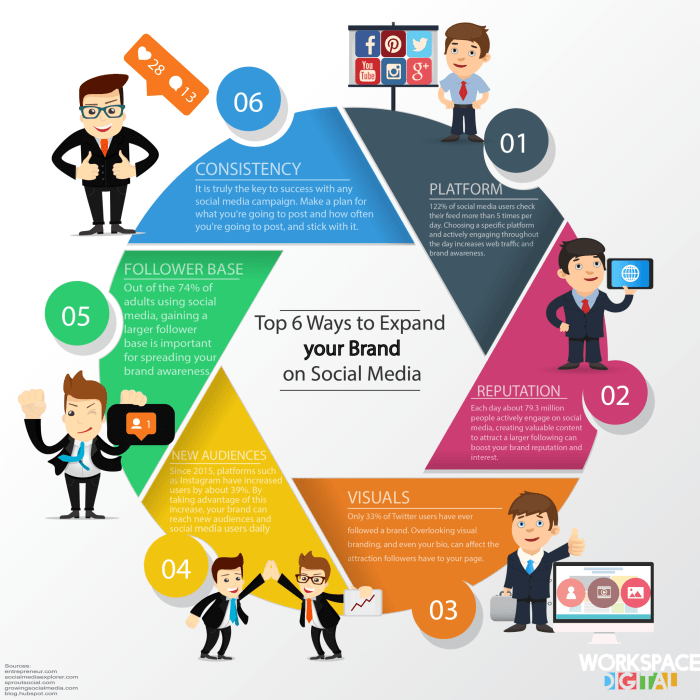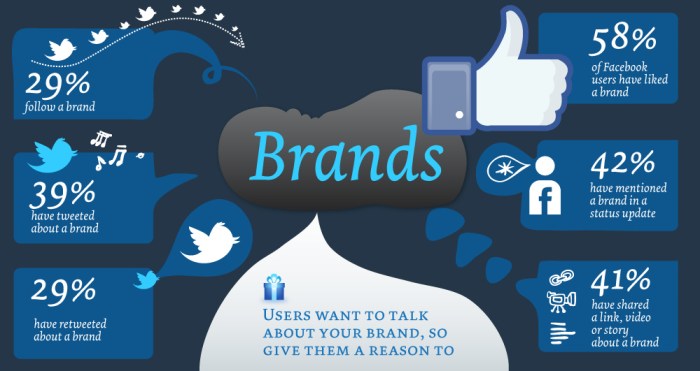Social Media Branding is where it’s at! Get ready to dive into the world of building a killer online presence that will set you apart from the crowd with style and substance.
Let’s explore the key elements and strategies that will take your brand to the next level in the digital realm.
Importance of Social Media Branding

In today’s digital age, social media branding plays a crucial role in the success of businesses. It allows companies to connect with their target audience, build brand awareness, and establish a strong online presence.
Examples of Successful Social Media Branding Strategies
- Creating engaging and shareable content that resonates with the target audience.
- Utilizing influencer partnerships to reach a wider audience and increase credibility.
- Consistent branding across all social media platforms to maintain a cohesive brand identity.
- Utilizing social media analytics to track performance and make data-driven decisions.
How Social Media Branding Impacts a Company’s Reputation and Visibility
Social media branding can significantly impact a company’s reputation and visibility in the following ways:
-
Increased brand loyalty
by engaging with customers and building strong relationships.
-
Enhanced brand recognition
through consistent branding elements and messaging.
-
Improved customer satisfaction
by providing timely responses and addressing concerns on social media platforms.
-
Increased website traffic and lead generation
through social media marketing efforts.
Elements of a Strong Social Media Branding Strategy
Creating a strong social media branding strategy requires a combination of key elements that work together to build a cohesive and engaging brand presence online. Consistency, storytelling, and engagement play crucial roles in shaping a successful social media branding strategy.
Consistency Across Platforms
Maintaining consistency in branding across different social media platforms is essential for establishing a recognizable and coherent brand identity. This includes using consistent visuals, messaging, and tone of voice across platforms to ensure that your audience can easily identify and connect with your brand. Consistency helps build trust and credibility with your audience, reinforcing your brand’s values and positioning in their minds.
- Use the same logo, color palette, and visual style across all platforms.
- Ensure that your messaging and brand voice are consistent in all communications.
- Create a content calendar to plan and schedule posts effectively across different platforms.
- Monitor and respond to comments and messages promptly to maintain a consistent brand image.
Storytelling and Engagement
Storytelling is a powerful tool in social media branding, allowing brands to connect with their audience on a deeper level by sharing authentic and compelling stories. Engaging content that resonates with your audience can help build emotional connections and foster loyalty towards your brand. Encouraging engagement through conversations, contests, polls, and user-generated content can also help strengthen your brand presence on social media.
- Share stories that highlight your brand values, mission, and unique selling points.
- Create interactive and engaging content that encourages likes, comments, and shares.
- Respond to comments and messages in a timely and personalized manner to show that you value your audience’s feedback.
- Collaborate with influencers and brand advocates to amplify your brand message and reach a wider audience.
Building Brand Personality on Social Media
Establishing a unique brand personality on social media is crucial for creating a strong connection with your audience. Your brand personality should reflect your values, mission, and overall identity. Here’s how you can build a distinctive brand personality on social media:
Role of Tone, Voice, and Visual Elements
When shaping your brand personality on social media, consider the following elements:
- Tone: The tone of your brand should be consistent across all platforms. Whether it’s playful, professional, or sarcastic, make sure it aligns with your brand values.
- Voice: Your brand voice is how you communicate with your audience. It should be authentic and resonate with your target demographic. Whether it’s witty, informative, or empathetic, maintain a consistent voice throughout your content.
- Visual Elements: The visual elements of your brand, including color schemes, logo, and imagery, play a significant role in shaping your brand personality. Make sure your visuals are cohesive and reflect the essence of your brand.
Some examples of brands with distinctive personalities on social media include:
- Wendy’s: Known for its sassy and humorous tone, Wendy’s engages with its audience through witty remarks and clever comebacks.
- Nike: Nike’s brand voice is empowering and motivational, inspiring its followers to push their limits and strive for greatness.
- Glossier: Glossier’s visual elements are minimalistic and clean, reflecting its commitment to simplicity and natural beauty.
Leveraging Influencers for Social Media Branding

In today’s digital age, collaborating with influencers has become a powerful strategy for enhancing social media branding. Influencers have a loyal following that trusts their opinions, making them valuable assets for promoting a brand and reaching a wider audience.
Benefits of Collaborating with Influencers
- Increased brand visibility: Influencers can expose your brand to their followers, boosting brand awareness.
- Authenticity: Followers perceive influencer recommendations as genuine, leading to higher credibility for your brand.
- Engagement: Influencers can create engaging content that resonates with their audience, driving interaction with your brand.
Tips for Choosing the Right Influencers
- Relevance: Select influencers whose niche aligns with your brand to ensure a natural fit.
- Audience demographics: Consider the demographics of the influencer’s followers to target the right audience for your brand.
- Engagement rate: Look for influencers with high engagement rates to ensure that their audience is actively involved.
Examples of Successful Influencer Partnerships, Social Media Branding
1. Daniel Wellington: The watch brand collaborated with multiple fashion influencers on Instagram, leading to a significant increase in brand visibility and sales.
2. Gymshark: The fitness apparel brand partnered with fitness influencers on YouTube to create workout videos, resulting in a boost in brand credibility and customer engagement.
3. SugarBearHair: The hair vitamin brand worked with beauty influencers on TikTok to promote their products, driving sales and brand loyalty among a younger audience.





